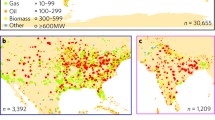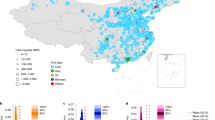Abstract
A method for estimating the pollution cost to society is presented that should help evaluate the relative societal benefit of new technologies. Thus, for every new process that is developed, one must factor in environmental costs to arrive at more realistic product costs. All new technologies should be compared on such a basis to arrive at the most competitive alternative. The method is illustrated with a new coal-burning power plant where reduction of SO2 emissions results in a reduction of the societal cost of electricity by 50%. The relative cost of electricity without SO2 control is 4.1c/kWh, and the cost of electricity with SO2 scrubbing is 4.2c/kWh. The implication is that it pays for a utility to scrub SO2 because it will avoid societal costs in the long run. Had the two numbers been very different, prudent management could then question the merits of either alternative.
Similar content being viewed by others
References
C.C. Travis, S.A. Richter, E.A.C. Crouch, R. Wilson, and E.D. Klema, “Cancer risk management”,Environ. Sci. Technol., vol. 21, pp. 415–420, 1987.
G.C. Thom and W.R. Ott,Atmospheric Environment, vol. 10, pp. 261–264, 1976.
L.R. Babcock, Jr. “A combined pollution index for measurement of total air pollution,”J. Air Pollution Contr. Assoc., vol. 20, p. 653, 1970.
L.S. Caretto and R.F. Sawyer, “The assignment of responsibility for air pollution,” SAE paper 720165, 1972.
“Cumulative regulatory effects on the cost of automative transportation (RECAT),” prepared for the Office of Science and Technology, Feb. 28, 1972.
“An example cost/benefit analysis of mobile source pollution control,” prepared by Mathematica, Inc. Princeton, NJ, for the U.S. Environmental Protection Agency.
B.-C. Liv et al., “Damage function for air pollutants,” prepared by the Midwest Research Institute, Kansas City, MO for the U.S. Environmental Protection Agency.
L.B. Barrett and T.E. Waddell, “Cost of air pollution damage: a status report,” U.S. Environmental Protection Agency, Research Triangle Park, NC, 1973.
T.E. Waddell, “The economic damages of air pollution,” EPA-600/5-74-012, U.S. Environmental Protection Agency, Washington, DC, May 1974.
M.G. Morgan et al.,Proc. IEEE, vol. 61, pp. 1431–1442, 1973.
K.A. Oleson and R.R. Boyle, “How to cool steam-electric power plants,”Chem. Eng. Prog., vol. 67, pp. 70–76, 1971.
J.W. Jones, and R.D. Stern, “Waste products from throwaway flue gas cleaning processes-Ecologically sound treatment and disposal,” Environmental Protection Agency, Pres. at Environmental Protection Agency Flue Gas Desulfurization Symposium, New Orleans, LA, May 14–17, 1973, 43 pp.; available from Control Systems Division, EPA, National Environmental Research Center, Research Triangle Park, NC, 27711.
R.J. Evans, “Potentional solid waste generation from lime and limestone desulfurization processes,” Bureau of Mines, I.C. 8633, 1974.
J.W. Jones, “Environmentally acceptable disposal of flue gas desulfurization sludges: The EPA research and development program,”Proc. Symp. onFlue Gas Desulfurization, EPA-650/2-74-126-a and b, NTIS PB 242 573, Dec. 1974, p. 887.
D.B. Boies et al., “Technical and economic evaluations of cooling systems blowdown control techniques,” U.S. Environmental Protection Agency, EPA-660/2-73-026, Nov. 1973.
D.C. Gifford, “Operation of a limestone wet scrubber,”Chem. Eng. Prog., vol. 69, pp. 86–92, 1973.
H.E. Christensen, ed., “The toxic substance — 1973 edition,” U.S. Dept. HEW, National Institute for Occupational Safety and Health, Rockville, MD, June, 1973.
“Threshold limit values for chemical substances in workroom air with intended changes for 1975,” American Conf. of Governmental Industrial Hygienists, P.O. Box 1937, Cincinnati, OH, 45201.
Federal Register, vol. 37, (202, 22139, Oct. 18, 1972).
C.E. Jahnig and H. Shaw, “A comparison of the environmental impact of conventional and fluid bed boilers in advanced steam power plants,”Proc. 12th Intersociety Energy Conversion Engineering Conf., vol. 1, pp. 670–674, 1977.
H. Shaw, “Pollution control and energy conversion efficiency of advanced power technologies,”Implications of the Clean Air Amendments of 1977 and of Energy Considerations for Air Pollution Control, W. Licht, ed., AIChE Symposium Series No. 196, pp. 1–16, 1980.
Author information
Authors and Affiliations
Rights and permissions
About this article
Cite this article
Shaw, H. Pollution ranking of new technologies. Journal of Systems Integration 2, 249–261 (1992). https://doi.org/10.1007/BF02265077
Received:
Issue Date:
DOI: https://doi.org/10.1007/BF02265077




